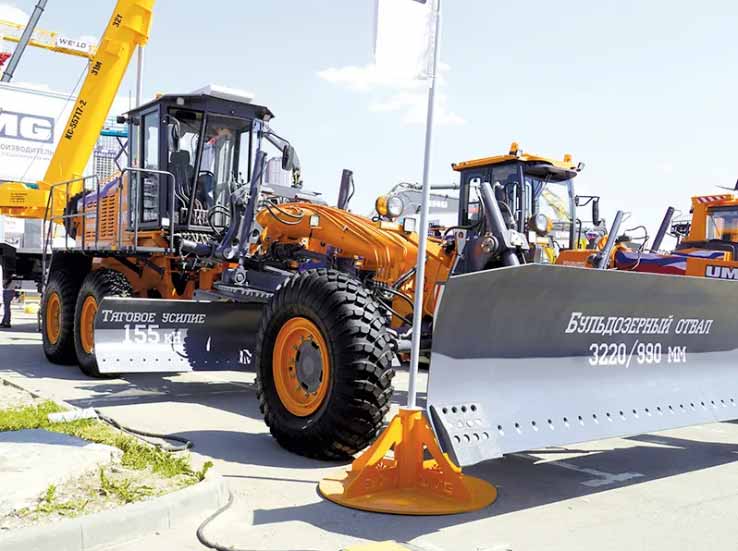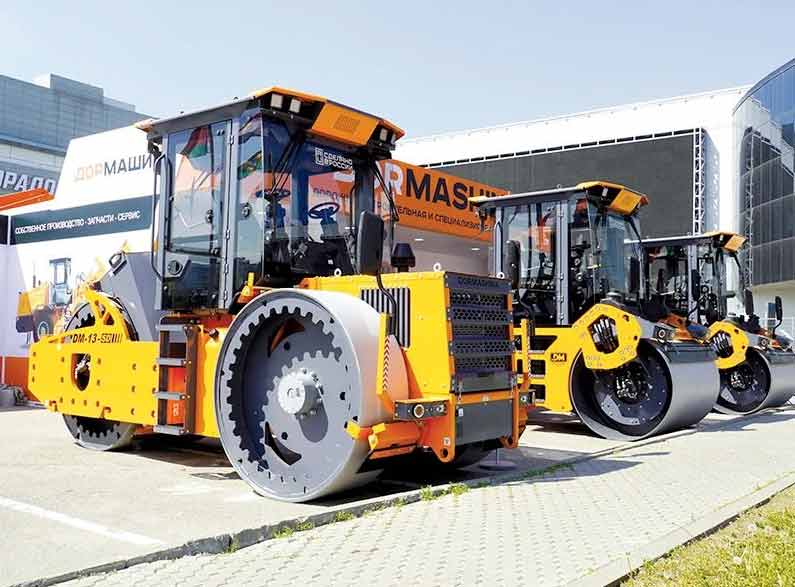Do You Need Help? Here Us : 電話番号 : +86 595 22486398
Do You Need Help? Here Us : 電話番号 : +86 595 22486398
中国とロシアの建設機械競争が新たな段階に突入
June 08, 2025中国とロシアの建設機械メーカー間の競争は徐々に最高潮に達し、ほとんどの種類の機械の輸入量が各社を緊張させています。注目すべきは、この状況が、長年市場に足場を築いてきたように見える大手メーカーでさえも深刻な打撃を与えていることです。実際、この業界の発展に向けた現実的なシナリオはほとんどなく、その実現は20年間揺るぎない政府の決定にかかっています。
「制裁は我が国の経済を壊滅させただけでなく、発展を刺激しました。この著しい成長は中国のパートナーのおかげです。建設機械部門の競争は非常に熾烈です。」と、分析機関「IDマーケティング」のコマーシャルディレクター、アンドレイ・ラブコフ氏は現状を説明した。
ここで重要なのは、中国からの機械輸入の増加に関する言及です。実際、統計データもこれを裏付けており、2023年には中国が市場シェアの82%を占めました。これに対し、ロシア特殊機械協会は、商工省および政府全体に対し、更なる支援策の実施を常に求めています。しかしながら、政府関係者は既に多くの対策を講じてきたと確信しています。
「我々は2014年初頭から、国内機械メーカーを支援する流れを提唱してきました。最も効果的な対策は、外国製機械の政府調達への参入禁止です。機械がロシアで製造されたかどうかを判断する基準が設けられ、製品がロシア国内で製造されたものとみなされるためには、どのような技術的工程がロシア国内で完了する必要があるかが定められました。さらに、国内機械メーカーは現在の課題への備えができています。トランスミッションシステム、油圧システム、電子部品など、一部の部品で若干の中断がありましたが、困難がなかったわけではありませんが、企業は新しい部品ベースへの移行に成功しています」と、ロシア産業貿易省農業・食品・建設機械部のスタニスラフ・チェルトレジスキー副部長は述べた。
もちろん、事態はそれほど単純ではありません。ロシア企業は鉄鋼部品の製造において進歩を遂げていますが、冶金工場との摩擦は依然として存在します。例えば、チェボクサル発電所は昨年、フォークリフト用ブリッジの製造技術を習得し、カマズ社と共同でタンデムブリッジを開発しました。また、エラブガ自動車工場と共同でバックホーローダー用ブリッジを4基設計しました。
「国産化の進捗は、メーカー自身の輸入品代替への意欲にかかっています。当社は長年にわたり、ロシア国内および世界各地に生産拠点を持つグローバル企業向けに、グレーダー、ローダーブリッジ、軌道システム部品、ポンプ設備部品を製造してきました。例えば、ウィログループは特別軍事作戦のずっと前から我が国と鋳物に信頼を寄せており、製品の国産化率は99%に達し、現在も市場シェアを拡大し続けています。」と、チェボクサルイ発電所ゼネラルマネージャーのアレクサンダー・ドミトリエフ氏は述べています。

しかし、ロシア国内でほとんど生産されていない部品ベースや、品質が非常に低い部品ベース、あるいは中国製部品で組み立てられ、高額なプレミアムが付けられている部品ベースも存在します。KAMAZ PJSCによるItelma社への非難、AvtoVAZによるAvtotor社への非難は、誰もがご存知でしょう。批判する側も大量の中国製部品を購入していますが。しかし、だからといって国内の機械製造工場が現地調達ポイントを獲得し、予算補助金を利用することを妨げるものではありません。公平を期すために言うと、ロシアには輸入部品への依存を可能な限り減らそうと真剣に取り組んでいるメーカーも確かに存在します。
商工省には一定のKPIがあり、技術主権への流れがあり、ロシアは外国メーカーの製品を現地化するための優れたツールを開発しています。私の隣にはUMG(ロシアの掘削機メーカー)の担当者が座っていましたが、私の見解では、ロシアでは掘削機の生産は全く行われていません。現在の市場シェアは非常に低く、統計的な誤差の範囲にも達していません。
しかし、商工省の特別投資契約、政令第823号「優遇リース」を通じて、今後数年のうちに少なくとも3社の掘削機メーカーが出現すると予測しています。その中には当社も含まれています。「今後3~8年で、これら3工場は市場の50%を占め、海外サプライヤーと競合するでしょう」と、チェトラ社のウラジミール・アントノフ取締役は述べています。さらに、アントノフ氏はチェトラブランドが既にローダーの生産を開始していることにも言及しました。アントノフ氏は、この分野でトップ3入りを目指しています。しかし、そのためには、商工省の担当者に対し、投資回収計画と新製品開発を明確にするための長期的な政府支援策を策定するよう要請しました。

もう一つの問題は、中国の機械販売業者と現地工場との対立です。現地工場は依然として中国からの部品供給にある程度依存していますが、現地市場での地位をめぐる競争は非常に熾烈です。「競争は良いことです。成熟した信頼できるメーカーが増えれば増えるほど、より良いのです」とウラジーミル・アントノフ氏は笑顔で語りました。
実際、ロシアは2021年まで「伸縮自在の武器」のような機械を生産しておらず、その後、UMGが参入した。しかし、欧州の部品サプライヤーが制裁を受けて撤退したため、UMGは新たなパートナーを見つけ、生産をブリャンスク兵器廠に移さなければならなかった。
同時に、中国のサプライヤーも、既に規模が小さい「テレスコピックアーム」市場に参入し始めています。現在、マニトウは依然として供給リーダーですが、XCMG、リンゴン、三一重工、ディエチなどが追い上げています。そして今、ロストセルマッシュもメーカーに加わり、2026年に量産開始を計画しています。「3,000台という台数では、現地化を徹底するには十分ではありませんが、市場の動向を分析した結果、今現地化しなければ将来問題が発生する可能性があると認識しました。他国の経験から、テレスコピックフォークリフトは幅広い用途から徐々に需要が伸びていることが分かります。」
「今年は若干の減速が見られましたが、この市場セグメントは機器の供給不足により成長しています。高品質な機械を製造しているメーカーは限られており、世界中で5~7社しかありません。ロストセルマッシュ社が製品を市場に投入すれば、同社の農業分野における地位を考えると、市場はさらに成長するでしょう。この分野ではテレハンドラーが広く使用されているため、彼らとの競争は熾烈になるでしょう」と、アレクセイ・スルハイ氏は認めました。
「ロシアの機器の99%は中国製なので、中国の技術を活用するべきだ。国内メーカーは10万台の中国製機械を輸入し、どうやって競争できるだろうか?」ベロポタポフ氏は、今後8年間で特別投資契約(SPIK)を実現する時間はなく、中国のパートナーを紹介し、全面的に協力する必要があると述べた。国際産業家・企業家会議は、主に国営企業や工業部門の企業を対象に、今後数年間の最終顧客向け受注計画をメーカーに提供する用意がある。
「2022年2月以降、中国から約160のブランドがロシアに進出しました。当社は製品ラインの継続的な更新と拡大により、生き残り、売上成長を維持することができました。機器の販売に注力するだけでなく、包括的なサービスも提供しています。全体的な統計をご覧ください。」と、XCMGディーラー「Сюйгун Ру」株式会社の営業部長、ヴァディム・ネチポレンコ氏は述べた。同時に、売上高減少の要因として、資本コストの上昇とスクラップリサイクル税の引き上げを挙げた。しかし、これらの動きは短期的なものであり、中国のサプライヤーはその後、価格調整や機械の生産コストの引き下げを行うだろう。しかし、こうした措置はまずロシアの消費者に悪影響を及ぼす。
XCMGの代表者は、これは主に2022年の制裁措置によってカザフスタンと中露国境間の通関地点で機械の滞留が発生し、その後それらが全てロシアに流入し、倉庫に滞留が発生したためだと説明した。そのため、現在中国から輸入される機械は多くなく、主に既存在庫の消化を目的としている。ネチポレンコ氏は、ロシアには依然として中国の主要サプライヤーすべてにとって十分な市場余地があると述べたが、次の金利引き上げとスクラップリサイクル税の引き上げという課題を誰が乗り越えられるかが問題だ。
したがって、商工省は特殊機械市場への外国企業の参入を支援する用意がありますが、その条件として、技術の現地化など、長期的協力関係の構築が挙げられます。これは、ロシアのパートナー企業と単独で、あるいは共同で行うものです。国内メーカーは現地化を進め、より大きな市場シェアを獲得していくでしょう。そして、今後5~8年で、この割合は50%に達すると予想されます。
現状、ロシア市場は徐々に現地化と協力へと歩みを進めています。多くの中国製機械ブランドがロシアに進出していますが、真に成功する協力モデルはまだ限られています。ロシア政府と産業界の後押しにより、現地生産が発展の鍵となっています。ロシアの建設機械市場は複雑で困難な時期を迎えています。現地生産と輸入代替政策の効果はまだ未知数ですが、中国との協力が今後の躍進の鍵となる可能性があります。
出典: 機械情報局

ぜひ読んで、最新情報を入手し、購読してください。ご意見をお聞かせください。
Add: Pudang Village, Xiamei Town, Nan'An City, Quanzhou, Fujian, China
泉州華茂機械設備有限公司 全著作権所有
.  サポートされているネットワーク
サイトマップ
| ブログ
| Xml | プライバシーポリシー
サポートされているネットワーク
サイトマップ
| ブログ
| Xml | プライバシーポリシー